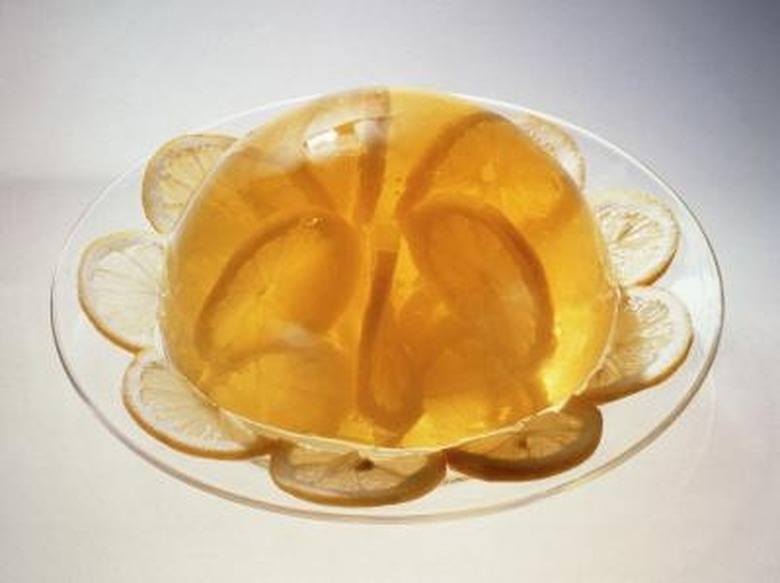Materials Needed To Make An Animal Cell Model
Learning, especially in science with all of its complexities, is easier when a visual model is available. The more fun the visual model, the more fun it is to learn, and the quicker someone is to retain it. There are several different ways to make a model of an animal cell, but one of the more interesting and thus memorable ways is to create an edible model out of Jello. Students will remember the parts of the cell more readily when they think of raisins and gumdrops.
Materials
Materials
To make the edible model, you will first need preparatory supplies of a stove or microwave for heating the water, a spoon to stir the Jello, a refrigerator to set the Jello and a large (1 gallon works well) plastic bag. For the various parts of the cell, you'll need light-colored Jello or unflavored gelatin, water and fruits and candies that should include a plum or other small pit fruit, sprinkles, jaw breakers, hard candy, gumball, M&Ms, gumdrops, raisins, jelly beans, grapes, regular gummy worms, sour gummy worms, mandarin orange sections and dried fruit. Substitutions with similar items are acceptable.
Process
Process
Prepare the light-colored Jello, but use less water than is normally indicated so that the result will be stiffer and help to hold the components in place. Place the open plastic bag in a sturdy container, like a bowl, and slowly pour the liquid Jello into it. Be certain there is enough room in the bag to add your components. Seal the bag and refrigerate it to set the Jello, which will usually about an hour. Take the Jello out of the refrigerator, however, before it is totally set so that the components can be added. Open the bag and add the various parts of the cell (the candies and fruit mentioned previously). Seal the bag again and place it back in the refrigerator to fully set.
Organelles
Organelles
The cytoplasm, the ground substance of a cell, is represented by the Jello. This is what all the other organelles inhabit. The cell membrane is represented by the plastic bag and is a thin layer that surrounds the cell. The plum will represent the nucleus, nucleolus and the nuclear membrane. The nucleus is the "brain" of the cell and takes care of various functions, which is the plum itself. The pit of the plum represents the nucleolus, where ribosomal RNA is produced. The skin of the plum equates to the nuclear membrane, which is similar to the cell membrane, but for the nucleus.
Mitochondria, which produce energy for the cell, are represented by raisins. The rough endoplasmic reticulum, which is called "rough" due to the ribosomes that cover it, moves materials through the cell and is represented by the sour gummy worms with their crystals of sourness to give it the rough appearance. The smooth endoplasmic reticulum adjoins to the rough one to transport materials from the rough endoplasmic reticulum to the Golgi body and is depicted by the regular gummy worms. The Golgi body itself packs materials into vesicles to move outside the cell, and should be shown in this model using a piece of folded ribbon hard candy.
Lysosomes, which are a type of vesicle containing digestive enzymes, can be represented by M&Ms. Vacuoles, which are also a type of vesicle, but for moving waste to the outside of the cell, can be shown by using jawbreakers. Cells have more ribosomes than just what are attached to the rough endoplasmic reticulum, and the free ribosomes can be represented by candy sprinkles. The final organelle to include in the animal cell model is the centrosome, which is a small body near the nucleus, and has an important function in cell division. The centrosome can be depicted with a gumball.
Have students create a chart of the various organelles and parts of the cell and label them with the item being used to depict them in the model.
References
Cite This Article
MLA
Clark, Jennifer L.. "Materials Needed To Make An Animal Cell Model" sciencing.com, https://www.sciencing.com/materials-make-animal-cell-model-5481891/. 24 April 2017.
APA
Clark, Jennifer L.. (2017, April 24). Materials Needed To Make An Animal Cell Model. sciencing.com. Retrieved from https://www.sciencing.com/materials-make-animal-cell-model-5481891/
Chicago
Clark, Jennifer L.. Materials Needed To Make An Animal Cell Model last modified March 24, 2022. https://www.sciencing.com/materials-make-animal-cell-model-5481891/
